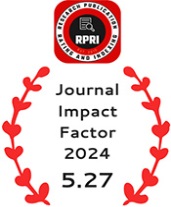Effect of Text-to-speech Software on Academic Achievement of Students with Dyslexia
DOI:
https://doi.org/10.55544/ijrah.2.4.45Keywords:
Dyslexia, Text-to-speech, Academic achievementAbstract
Dyslexia is a neurobiological disorder that creates serious difficulties in learning process. Being a special learning disorder, it demands special learning environment with a blend of right approach, method and technology. Text to speech software comes under the head of assistive technology that helps dyslexic children understand and assimilate structure sound and meaning of the words. Present study is an experimental study in which 20 students of 6-12 years of age range were selected and randomly distributed in experimental and control group. Experimental group was taught with text to speech software for four months while control group received no treatment and was taught by conventional method of teaching. In the beginning of the study a pretest was conducted in order to know the prevalent differences among the groups. After four months of intervention post test was conducted. Results revealed that students in experimental group performed significantly better than the control group. Text to speech software contributed to remarkable gains in the achievement of students with dyslexia.
Downloads
References
American Psychiatric Association. (2013). Diagnostic and statistical manual of mental disorders (DSM-5®). https://psychiatry.org/patients-families/specific-learning-disorder/what-is-specific-learning-disorder
Catts, H. W., Adolf, S. M., Hogan, T. P. & Ellis Welsmer, S. 2005. Are specific language impairment and dyslexia distinct disorders? journal of Speech, Hearing and Language Research. 48(6), 1378-1396. https://doi.org/10.1044/1092-4388(2005/096)
Cook, V. J. 1977. Cognitive processes in second language learning. International Review of Applied Linguistics. 15(1), 1-20
Dalton, B., Winbury, N. E. & Morocco, C. C. (1990). If you could just push a button: Two forth grade boys with learning disabilities learn to use computer spelling checkers. Journal of Special Educatioal Technology. 19(4), 57-80
Elkind, J., Cohen, C. & Murrey, C. (1993). Using computer based readers to improve reading comprehension of students with dyslexia. Annals of Dyslexia. 43, 238-259
Joshi, R.M., Dahlgren, M. & Boulware-Gooden, R. (2002). Teaching reading in an inner city school through a multisensory teaching approach. Annals of Dyslexia. 52(1), 229-242
Kramer, J. H., Knee, K. & Delis, D. C. (2000). Verbal memory impairments in dyslexia. Archives of Clinical Neuropsychology, 15(1), 83-93. https://doi.org/10.1016/S0887-6177(99)00022-0
Mayer, R. E. (2014). Cognitive theory of multimedia learning. In R. E. Mayer (Ed.), The Cambridge handbook of multimedia learning, 43-71. Cambridge University Press. https://doi.org/10.1017/CBO9781139547369.005
McGrath, L. M., Peterson, R. L., & Pennington, B. F. (2020). The multiple deficit model: Progress, problems, and prospects. Scientific Studies of Reading, 24(1), 7-13. https://doi.org/10.1080/10888438.2019.1706180
Omidian, F. and Nolaei, F. (2021). investigating the dyslexia of pre school students and presenting educational strategies by combined method. Journal of Educational Studies. 18, 59-68.
Perry, C., Zorzi, M. & Ziegler, J. C. (2019). Understanding the dyslexia through personalized large-scale computational models. Psychological Science. 30(3), 386-395
Rasking, M. H. & Higgins, E. (1995). Effects of speech synthesis on the proofreading efficiency of postsecondary students with learning disabilities. Learning Disability Quarterly, 18, 141-158
Richardson, S.O. (1992). Historical perspectives on dyslexia. Journal of learning disabilities. 25(1), 40-47. https://doi.org/10.1177/002221949202500107
Riddell, S. and Weedon, E. (2006). what counts as a reasonable adjustment? Dyslexic students and the concept of fair assessment. International Studies in Sociology of Education. 16, 57-73. https://doi.org/10.1080/19620210600804301
Schiavo,G, Mana, N., Mich, O., Zan Canaro, M, & Job, R. (2021). Attention driven read aloud technology increases reading comprehension in children with reading disabilities. 37(3), 875-886. https://doi.org/10.1111/jcal.12530
Schneps, M. H., Chen, C., Pomplun, M., Wang, J., Crosby, A. D., & Kent, K. (2019). Pushing the speed of assistive technologies for reading. Mind, Brain, and Education, 13(1), 14- 29. https://doi.org/10.1111/mbe.12180
Shankweiler, D., Liberman, I. Y, Mark, L. S., Fowler, C. A. and Fisher, F. W. (1979). The speech code and learning to read. Journal of Experimental Psychology: Human Learning and Memory. 5(6), 531-545. https://doi.org/10.1037/0278.5.6531
Shaywitz, S. E., Shaywitz, B. A., Fulbright, R. K., Skudlarski, P., Menci, W. E., Constable, R. T. et. al. (2003). Neural systems for compensation and persistence: young adult outcome of childhood reading disability. Biological Pscychiatry .54 (1), 25-33
Snowling, M. J. (2013). Early identification and interventions for dyslexia; a contemporary view. Journal of Research in Special Educational needs, 13(1), 7-14
Snowling, M. J. (2019). Dyslexia: A very short introduction. Oxford university press. 20-33. https://doi.org/10.1093/actrade/9780198818304
Snowling, M. J., Hayiou-Thomas, M. E., Nash, H. M., & Hulme, C. (2020). Dyslexia and developmental language disorder: Comorbid disorders with distinct effects on reading comprehension. Journal of Child Psychology and Psychiatry, 61(6), 672– 680. https://doi.org/10.1111/jcpp.13140
Thompson, J. (2010). Good practice in interventions for teaching dyslexic learners and in teacher training in English speaking countries. Harvard Graduate School of Education.
Wood, S. G., Moxley, J. H., Tighe, E. L., & Wagner, R. K. (2018). Does use of text-to-speech and related read-aloud tools improve reading comprehension for students with reading disabilities? A meta-analysis. Journal of Learning Disabilities, 51(1), 73– 84. https://doi.org/10.1177/002221941668817
Downloads
Published
How to Cite
Issue
Section
License
Copyright (c) 2022 Integrated Journal for Research in Arts and Humanities

This work is licensed under a Creative Commons Attribution-NonCommercial-NoDerivatives 4.0 International License.




















